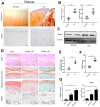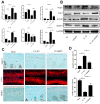BMP5 silencing inhibits chondrocyte senescence and apoptosis as well as osteoarthritis progression in mice
- PMID: 33744859
- PMCID: PMC8064147
- DOI: 10.18632/aging.202708
BMP5 silencing inhibits chondrocyte senescence and apoptosis as well as osteoarthritis progression in mice
Abstract
In this study, we using the in vivo destabilization of the medial meniscus (DMM) mouse model to investigate the role of bone morphogenetic protein 5 (BMP5) in osteoarthritis (OA) progression mediated via chondrocyte senescence and apoptosis. BMP5 expression was significantly higher in knee articular cartilage tissues of OA patients and DMM model mice than the corresponding controls. The Osteoarthritis Research Society International scores based on histological staining of knee articular cartilage sections were lower in DMM mice where BMP5 was knocked down in chondrocytes than the corresponding controls 4 weeks after DMM surgery. DMM mice with BMP5-deficient chondrocytes showed reduced levels of matrix-degrading enzymes such as MMP13 and ADAMTS5 as well as reduced cartilage destruction. BMP5 knockdown also decreased chondrocyte apoptosis and senescence by suppressing the activation of p38 and ERK MAP kinases. These findings demonstrate that BMP5 silencing inhibits chondrocyte senescence and apoptosis as well as OA progression by downregulating activity in the p38/ERK signaling pathway.
Keywords: BMP5; chondrocyte; osteoarthritis; p38/ERK; senescence.
Conflict of interest statement
Figures






Similar articles
-
Anemonin attenuates osteoarthritis progression through inhibiting the activation of IL-1β/NF-κB pathway.J Cell Mol Med. 2017 Dec;21(12):3231-3243. doi: 10.1111/jcmm.13227. Epub 2017 Jun 23. J Cell Mol Med. 2017. PMID: 28643466 Free PMC article.
-
Deferoxamine alleviates chondrocyte senescence and osteoarthritis progression by maintaining iron homeostasis.Int Immunopharmacol. 2024 Sep 30;139:112619. doi: 10.1016/j.intimp.2024.112619. Epub 2024 Jul 17. Int Immunopharmacol. 2024. PMID: 39024748
-
Systemic inhibition of IL-6/Stat3 signalling protects against experimental osteoarthritis.Ann Rheum Dis. 2017 Apr;76(4):748-755. doi: 10.1136/annrheumdis-2016-209757. Epub 2016 Oct 27. Ann Rheum Dis. 2017. PMID: 27789465
-
The Role of Chondrocyte Hypertrophy and Senescence in Osteoarthritis Initiation and Progression.Int J Mol Sci. 2020 Mar 29;21(7):2358. doi: 10.3390/ijms21072358. Int J Mol Sci. 2020. PMID: 32235300 Free PMC article. Review.
-
Exploration and breakthrough in the mode of chondrocyte death - A potential new mechanism for osteoarthritis.Biomed Pharmacother. 2024 Jan;170:115990. doi: 10.1016/j.biopha.2023.115990. Epub 2023 Dec 6. Biomed Pharmacother. 2024. PMID: 38061136 Review.
Cited by
-
Inhibiting thyroid activation in aged human explants prevents mechanical induced detrimental signalling by mitigating metabolic processes.Rheumatology (Oxford). 2022 Dec 23;62(1):457-466. doi: 10.1093/rheumatology/keac202. Rheumatology (Oxford). 2022. PMID: 35383365 Free PMC article.
-
RPL35 downregulated by mechanical overloading promotes chondrocyte senescence and osteoarthritis development via Hedgehog-Gli1 signaling.J Orthop Translat. 2024 Apr 1;45:226-235. doi: 10.1016/j.jot.2024.01.003. eCollection 2024 Mar. J Orthop Translat. 2024. PMID: 38596341 Free PMC article.
-
Advances in understanding effects of miRNAs on apoptosis, autophagy, and pyroptosis in knee osteoarthritis.Mol Genet Genomics. 2023 Nov;298(6):1261-1278. doi: 10.1007/s00438-023-02077-3. Epub 2023 Nov 2. Mol Genet Genomics. 2023. PMID: 37914978 Review.
-
BMP5 signalling in beta cells and the impact on insulin secretion in the context of type 2 diabetes.Diabetologia. 2025 Sep;68(9):1983-1996. doi: 10.1007/s00125-025-06457-9. Epub 2025 Jun 5. Diabetologia. 2025. PMID: 40471239 Free PMC article.
-
Single-cell transcriptome and crosstalk analysis reveals immune alterations and key pathways in the bone marrow of knee OA patients.iScience. 2024 Aug 26;27(9):110827. doi: 10.1016/j.isci.2024.110827. eCollection 2024 Sep 20. iScience. 2024. PMID: 39310769 Free PMC article.
References
-
- Little CB, Barai A, Burkhardt D, Smith SM, Fosang AJ, Werb Z, Shah M, Thompson EW. Matrix metalloproteinase 13-deficient mice are resistant to osteoarthritic cartilage erosion but not chondrocyte hypertrophy or osteophyte development. Arthritis Rheum. 2009; 60:3723–33. 10.1002/art.25002 - DOI - PMC - PubMed
Publication types
MeSH terms
Substances
LinkOut - more resources
Full Text Sources
Other Literature Sources
Medical
Miscellaneous

